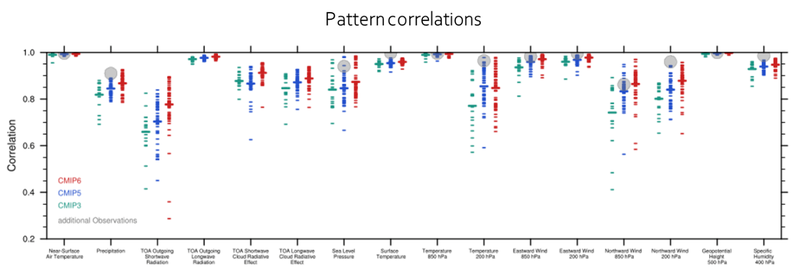ESA CCI data for model evaluation: using ESMValTool to validate CMIP6 models
Key Highlights
- ESA CCI ECV data were used in latest IPCC report
- ESA CCI ECV datasets are key for evaluation of Earth System Models
- ESMValTool is a community tool which compares models with each other and with observations
- CMUG are adding CCI data diagnostics to ESMValTool
- ESMValTool diagnostics using CCI datasets to evaluate CMIP6 models are used in the IPCC AR6 report
Background
The World Climate Research Programme (WCRP)[1] climate model intercomparison project (CMIP) coordinates an international effort comparing climate models, providing a basis for climate research and a reference for influential reports such as the recent IPCC AR6[2] (IPCC, 2021). The latest phase is CMIP6[3].
The Earth System Model Evaluation Tool (ESMValTool)[4] is designed to work with the CMIP Earth System Models (ESMs), which simulate the atmosphere, ocean and land surface and their interactions (Bock et al., 2020). ESMValTool is an open access diagnostics and performance metrics tool which compares ESMs with each other and with observations and generates pre-defined statistics or diagnostics. ESMValTool provides easy access to these climate diagnostics and allows users to take advantage of developments made by the climate modelling community. It also allows easy dissemination of results (Eyring et al., 2016).
CMUG is working to add ESA CCI ECV dataset diagnostics to ESMValTool in order to promote uptake of the data in a wide range of research and in reports such as the IPCC AR6.
Motivation
Earth System Models (ESMs) are vital for understanding past, present and future climate. Some aspects of the Earth system are poorly represented in numerical models (e.g., coupled tropical climate variability; monsoons; Southern Ocean processes; continental dry biases and soil hydrology-climate interactions; atmospheric CO2 budgets; ozone; and tropospheric aerosols) and comparison with reliable observations can provide vital insight into where model development efforts should be focused.
[1] https://www.wcrp-climate.org/
[2] https://www.ipcc.ch/report/ar6/wg1/
[3] https://pcmdi.llnl.gov/CMIP6/Guide/dataUsers.html
Detailed knowledge of a model’s skill in reproducing observations is also vital for the correct interpretation of the model results of future projections.
The ESA CCI offers ECV datasets from satellite observations with good spatial and temporal coverage, long time series, consistency, traceability and documentation. Combined with ESMValTool they provide a powerful validation dataset for the CMIP6 models.
Progress
Most recently, CMUG has added diagnostics from five ESA CCI datasets to ESMValTool:
- Land Surface Temperature (LST)
- Greenhouse Gases (CH4)
- Water Vapour
- Sea Surface Salinity (SSS)
- Ocean Colour (OC)
A further eight CCI ECVs were added by CMUG in the previous phase of the project, bringing the total to 13. These further eight ECVs are listed below:
- Sea Surface Temperature (SST)
- Sea Ice
- Cloud
- Soil Moisture
- Land Cover
- Aerosol
- Ozone
- Greenhouse Gases (CO2)
See Lauer et al. (2017) reference (listed in full below) for further details on these earlier eight ECVs.
The IPCC AR6 report Chapters 3 and 4, on the present and future climate, use multiple lines of evidence, including results from ESMValTool to evaluate CMIP models (IPCC, 2021), for which the CCI datasets are a key component. Figure 1 shows how one aspect of the CMIP4, CMIP5 and CMIP6 models is compared for a number of metrics and how observation data are used to assess performance.

References
- Bock, L., A. Lauer, M. Schlund, M. Barreiro, N. Bellouin, C. Jones, G. A. Meehl, V. Predoi, M. J. Roberts, V. Eyring: Quantifying Progress Across Different CMIP Phases With the ESMValTool, J. Geophys. Res., 125, e2019JD032321, doi: 10.1029/2019JD032321, 2020.
- Eyring, V., Righi, M., Evaldsson, M., Lauer, A., Wenzel, S., Jones, C., Anav, A., Andrews, O., Cionni, I., Davin, E. L., Deser, C., Ehbrecht, C., Friedlingstein, P., Gleckler, P., Gottschaldt, K.-D., Hagemann, S., Juckes, M., Kindermann, S., Krasting, J., Kunert, D., Levine, R., Loew, A., Mäkelä, J., Martin, G., Mason, E., Phillips, A., Read, S., Rio, C., Roehrig, R., Senftleben, D., Sterl, A., van Ulft, L. H., Walton, J., Wang, S., and Williams, K. D. 2015: ESMValTool (v1.0) - a community diagnostic and performance metrics tool for routine evaluation of Earth System Models in CMIP, Geosci. Model Dev., 9, 1747-1802, doi:10.5194/gmd-9-1747-2016, 2016.
- IPCC, 2021: Summary for Policymakers. In: Climate Change 2021: The Physical Science Basis. Contribution of Working Group I to the Sixth Assessment Report of the Intergovernmental Panel on Climate Change [Masson-Delmotte, V., P. Zhai, A. Pirani, S. L. Connors, C. Péan, S. Berger, N. Caud, Y. Chen, L. Goldfarb, M. I. Gomis, M. Huang, K. Leitzell, E. Lonnoy, J.B.R. Matthews, T. K. Maycock, T. Waterfield, O. Yelekçi, R. Yu and B. Zhou (eds.)]. Cambridge University Press. In Press.
- Lauer, A., V. Eyring, M. Righi, M. Buchwitz, P. Defourny, M. Evaldsson, P. Friedlingstein, R. de Jeu, G. Leeuw, A. Loew, C.J. Merchant, B. Müller, T.Popp, M. Reuter, S. Sandven, U. Willén. 2017: Benchmarking CMIP5 models with a subset of ESA CCI Phase 2 data using the ESMValTool. Remote Sensing of Environment. Volume 203, 15 December 2017, Pages 9-39. https://doi.org/10.1016/j.rse.2017.01.007
About the author

This article was produced in 2022 by Axel Lauer. Axel is a senior researcher with DLR, is leading the development of data benchmarking using the ESMValTool for the cross-assessment of aerosol, cloud and radiation essential climate variables.

